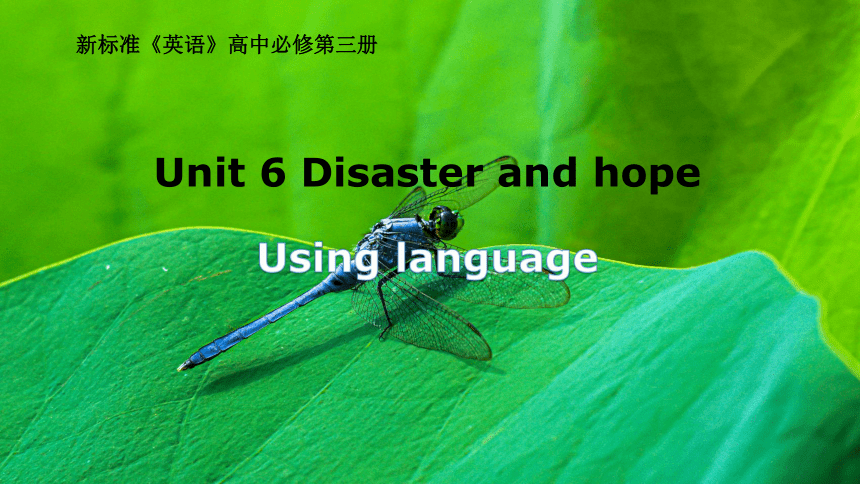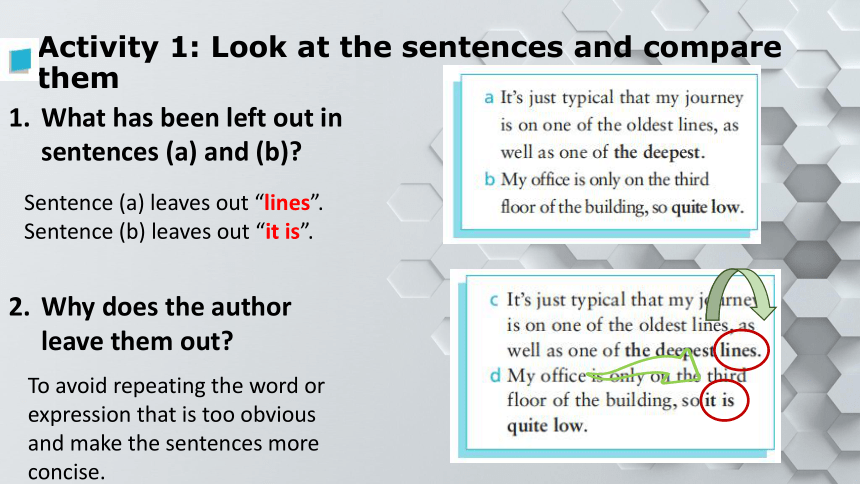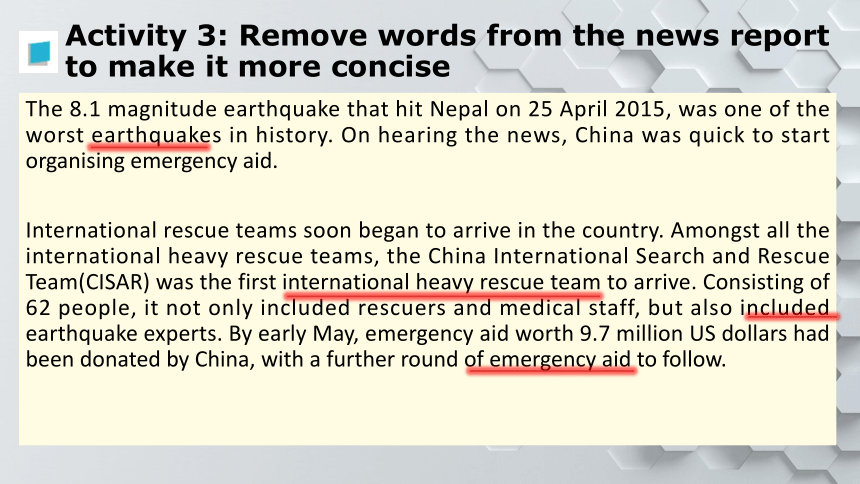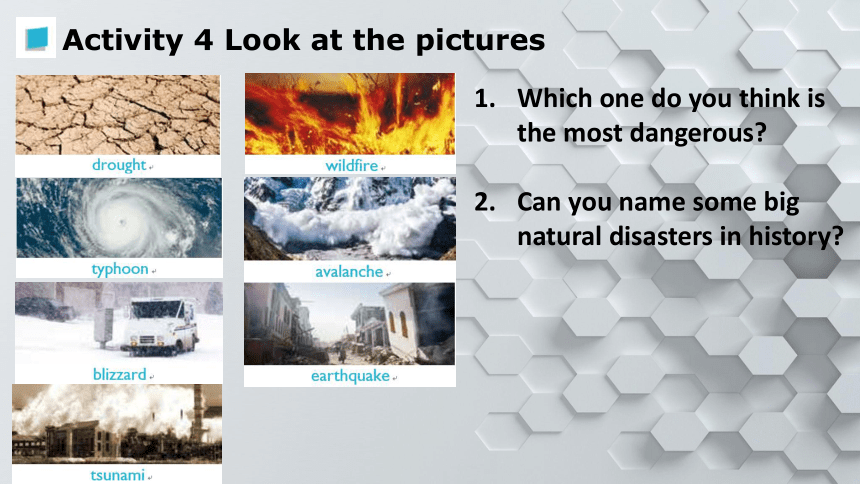Unit 6 Disaster and hope Using language课件(共16张)--2024-2025学年高中《英语》必修3(外研版)
文档属性
| 名称 | Unit 6 Disaster and hope Using language课件(共16张)--2024-2025学年高中《英语》必修3(外研版) |  | |
| 格式 | pptx | ||
| 文件大小 | 3.1MB | ||
| 资源类型 | 教案 | ||
| 版本资源 | 外研版(2019) | ||
| 科目 | 英语 | ||
| 更新时间 | 2025-07-05 21:05:22 | ||
图片预览







文档简介
(共16张PPT)
Unit 6 Disaster and hope
Using language
新标准《英语》高中必修第三册
Ellipsis
Activity 1: Look at the sentences and compare them
What has been left out in sentences (a) and (b)
Why does the author leave them out
Sentence (a) leaves out “lines”.
Sentence (b) leaves out “it is”.
To avoid repeating the word or expression that is too obvious and make the sentences more concise.
Activity 2
Find out what words have been removed before or after the underlined words.
its ways (to forecast the weather)
dry period (that’s on the way)
more loudly (than usual)
(look) for birds
when and where (something bad is going to happen)
Activity 3: Remove words from the news report to make it more concise
The 8.1 magnitude earthquake that hit Nepal on 25 April 2015, was one of the worst earthquakes in history. On hearing the news, China was quick to start organising emergency aid.
International rescue teams soon began to arrive in the country. Amongst all the international heavy rescue teams, the China International Search and Rescue Team(CISAR) was the first international heavy rescue team to arrive. Consisting of 62 people, it not only included rescuers and medical staff, but also included earthquake experts. By early May, emergency aid worth 9.7 million US dollars had been donated by China, with a further round of emergency aid to follow.
Types of natural disasters
Activity 4 Look at the pictures
Which one do you think is the most dangerous
Can you name some big natural disasters in history
Activity 5: Complete the reports
typhoon
wildfire
avalanches
earthquake
tsunami
blizzard
drought
Summarise the words describing natural disasters
Activity 6: Talk about a recent natural disaster you have heard about or seen
Extreme weather conditions
What do you know about weather forecasting
Activity 7: Listen & Match
a-Washington, DC
b-San Francisco
c-Anchorage
d-Houston
e-Phoenix
Activity 8
warm clothes
-15
fry meat on the road
get medical attention
hurricane
safe indoors
13
through floodwaters
25
wildfires
Activity 9
Work in pairs. Act out the conversation to talk about an extreme weather condition.
Student A: Turn to Page 108.
Student B: Turn to Page 113.
Activity 10
Work in pairs. Choose another extreme weather condition and have a similar conversation.
THANK YOU
Unit 6 Disaster and hope
Using language
新标准《英语》高中必修第三册
Ellipsis
Activity 1: Look at the sentences and compare them
What has been left out in sentences (a) and (b)
Why does the author leave them out
Sentence (a) leaves out “lines”.
Sentence (b) leaves out “it is”.
To avoid repeating the word or expression that is too obvious and make the sentences more concise.
Activity 2
Find out what words have been removed before or after the underlined words.
its ways (to forecast the weather)
dry period (that’s on the way)
more loudly (than usual)
(look) for birds
when and where (something bad is going to happen)
Activity 3: Remove words from the news report to make it more concise
The 8.1 magnitude earthquake that hit Nepal on 25 April 2015, was one of the worst earthquakes in history. On hearing the news, China was quick to start organising emergency aid.
International rescue teams soon began to arrive in the country. Amongst all the international heavy rescue teams, the China International Search and Rescue Team(CISAR) was the first international heavy rescue team to arrive. Consisting of 62 people, it not only included rescuers and medical staff, but also included earthquake experts. By early May, emergency aid worth 9.7 million US dollars had been donated by China, with a further round of emergency aid to follow.
Types of natural disasters
Activity 4 Look at the pictures
Which one do you think is the most dangerous
Can you name some big natural disasters in history
Activity 5: Complete the reports
typhoon
wildfire
avalanches
earthquake
tsunami
blizzard
drought
Summarise the words describing natural disasters
Activity 6: Talk about a recent natural disaster you have heard about or seen
Extreme weather conditions
What do you know about weather forecasting
Activity 7: Listen & Match
a-Washington, DC
b-San Francisco
c-Anchorage
d-Houston
e-Phoenix
Activity 8
warm clothes
-15
fry meat on the road
get medical attention
hurricane
safe indoors
13
through floodwaters
25
wildfires
Activity 9
Work in pairs. Act out the conversation to talk about an extreme weather condition.
Student A: Turn to Page 108.
Student B: Turn to Page 113.
Activity 10
Work in pairs. Choose another extreme weather condition and have a similar conversation.
THANK YOU
